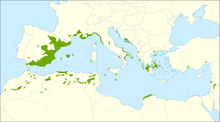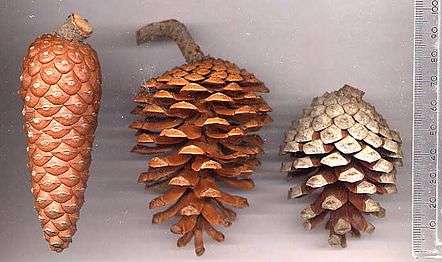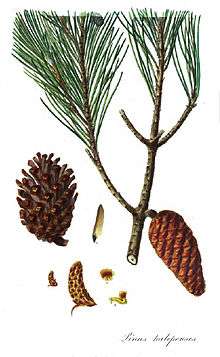Pinus halepensis
| Pinus halepensis | |
|---|---|
 | |
| P. halepensis on the Calanque de Port-Pin, France | |
| Scientific classification | |
| Kingdom: | Plantae |
| Division: | Pinophyta |
| Class: | Pinopsida |
| Order: | Pinales |
| Family: | Pinaceae |
| Genus: | Pinus |
| Subgenus: | Pinus |
| Species: | P. halepensis |
| Binomial name | |
| Pinus halepensis Miller | |
 | |
| Distribution map | |
Pinus halepensis, commonly known as the Aleppo pine, is a pine native to the Mediterranean region. Its range extends from Morocco, Algeria and Spain north to southern France, Italy, Croatia, Montenegro, Albania, and east to Greece, all over Malta and northern Tunisia, with an outlying population (from which it was first described) in Syria, Lebanon, southern Turkey, Jordan, Israel, and Palestinian territories. In Israel it is called Jerusalem pine.
Distribution
Pinus halepensis, the Aleppo pine, is generally found at low altitudes, mostly from sea level to 200 m (660 ft), but can grow up to 1,000 m (3,300 ft) in southern Spain, well over 1,200 m (3,900 ft) on Crete, and up to 1,700 m (5,600 ft) in the south, in Morocco, Algeria and Tunisia.[2][3] The tree is able to quickly colonize open and disturbed areas. It can grow on all substrates and almost in all bioclimates in the Mediterranean.[4]
Description
P. halepensis is a small to medium-sized tree, 15–25 m (49–82 ft) tall, with a trunk diameter up to 60 cm (24 in), exceptionally up to 1 m (3 ft 3 in). The bark is orange-red, thick, and deeply fissured at the base of the trunk, and thin and flaky in the upper crown. The leaves ("needles") are very slender, 6–12 cm (2.4–4.7 in) long, distinctly yellowish green, and produced in pairs (rarely a few in threes). The cones are narrow conic, 5–12 cm (2.0–4.7 in) long and 2–3 cm (0.79–1.18 in) broad at the base when closed, green at first, ripening glossy red-brown when 24 months old. They open slowly over the next few years, a process quickened if they are exposed to heat such as in forest fires. The cones open 5–8 cm (2.0–3.1 in) wide to allow the seeds to disperse. The seeds are 5–6 mm (0.20–0.24 in) long, with a 20-mm wing, and are wind-dispersed.[2][3][5]
 Cones
Cones Foliage
Foliage Bark and trunk
Bark and trunk Plate from Lambert's Description of the Genus Pinus
Plate from Lambert's Description of the Genus Pinus Cone of pinus halepensis in Hebron, West Bank
Cone of pinus halepensis in Hebron, West Bank
Related species
The Aleppo pine is closely related to the Turkish pine, Canary Island pine, and maritime pine, which all share many of its characteristics. Some authors include the Turkish pine as a subspecies of the Aleppo pine, as Pinus halepensis subsp. brutia (Ten.) Holmboe,[6] but it is usually regarded as a distinct species.[2][3][5][7] It is a relatively nonvariable species, in that its morphological characteristics stay constant over the entire range.[2]
Uses
The resin of the Aleppo pine is used to flavor the Greek wine retsina.
From the pine nuts of the Aleppo pine is made a pudding called asidet zgougou in the Tunisian dialect; it is served in bowls, covered with cream, and topped with almonds and small candies.
Aleppo pine are used for bonsai.
Forestry

In its native area, P. halepensis is widely planted for its fine timber, making it one of the most important forestry trees in Algeria and Morocco.[5] In Israel, the Aleppo pine, along with Pinus brutia, has been planted extensively by the JNF. It proved very successful in Yatir Forest in the northern Negev (on the edge of the desert), where foresters had not expected it to survive. Many Aleppo pine forests exist today in Israel and are used for recreational purposes. Although it is a local species, some argue that the historical replacement of natural oak Maquis shrubland and garrigue with tall stands of pine has created "ecological deserts" and has significantly changed the species assemblage of these regions.[8] In Israel natural patches of Aleppo pine forests can be found in the Carmel and Galilee regions.[9] The species produces timber which is valued for its hardness, density and unproblematic seasoning. Seasoned timber is inclined to tear out with planing, but this can be avoided by using sharp blades or adjusting the sharpening angle of tools.[10]
The Aleppo pine is considered an invasive species though useful in South Africa; in South Australia, a control program is in place on Eyre Peninsula.
Landscape

P. halepensis is a popular ornamental tree, extensively planted in gardens, parks, and private and agency landscapes in hot dry areas such as Southern California and the Karoo in South Africa, where the Aleppo pine's considerable heat and drought tolerance, fast growth, and aesthetic qualities, are highly valued.
Cultural references
Paul Cézanne had an Aleppo pine in his garden at Aix-en-Provence; this tree was the inspiration and model for his painting, The Big Trees. As of 2005, the tree is still growing in Cézanne's garden.[11]
References
- ↑ Conifer Specialist Group (1998). "Pinus halepensis". IUCN Red List of Threatened Species. Version 2006. International Union for Conservation of Nature. Retrieved 12 May 2006.
- 1 2 3 4 Farjon, A. (2005). Pines. Drawings and Descriptions of the genus Pinus. Brill, Leiden. ISBN 90-04-13916-8.
- 1 2 3 Rushforth, K. (1999). Trees of Britain and Europe. Collins ISBN 0-00-220013-9.
- ↑ Facy, B., Semerci, H. & Vendramin, G.G. (2003). "Aleppo and Brutia pines - Pinus halepensis/Pinus brutia" (PDF). EUFORGEN Technical guidelines for genetic conservation and use.
- 1 2 3 Nahal, I. (1962). Le Pin d'Alep (Pinus halepensis Miller). Étude taxonomique, phytogéographique, écologique et sylvicole. Annales de l'École National des Eaux et Forêts (Nancy) 19: 1–207.
- ↑ Christensen, K. I. (1997). Gymnospermae. Pp. 1–17 in Strid, A., & Tan, K., eds., Flora Hellenica 1. Königstein.
- ↑ Richardson, D. M., ed. (1998). Ecology and Biogeography of Pinus. Cambridge University Press ISBN 0-521-55176-5.
- ↑ F.T. Maestre, J. Cortina . "Are Pinus halepensis plantations useful as a restoration tool in semiarid Mediterranean areas?" Forest Ecology and Management, 2004 -(Elsevier) 2004.
- ↑ Newman Information Center for Desert Research and Development, Aleppo pine
- ↑ Reducing Tear Out when Wood Planing
- ↑ Cézanne, P. Visions. In Architectural Digest December 2005: 117.
External links
 Media related to Pinus halepensis at Wikimedia Commons
Media related to Pinus halepensis at Wikimedia Commons Data related to Pinus halepensis at Wikispecies
Data related to Pinus halepensis at Wikispecies- Gymnosperm Database: Pinus halepensis
- EUFORGEN species page: Pinus halepensis. Distribution, information and related resources.
